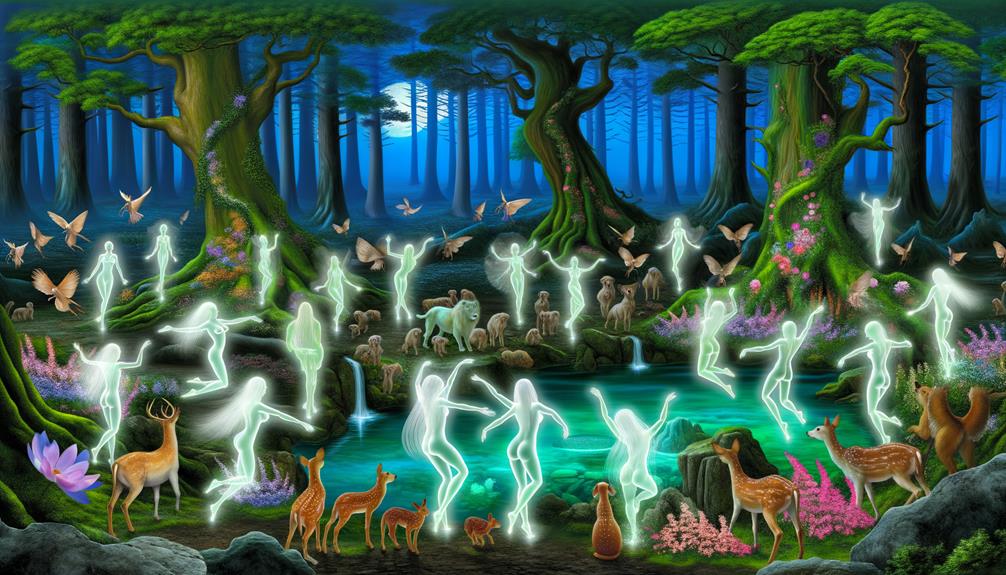Just like the gentle winds that rustle leaves or the soft sound of water flowing through a forest, the charm and mystery of nymphs, those magical spirits of nature, have drawn people in since the old days. When I flip through pages of old myths and legends, these supernatural creatures, often imagined as beautiful young women, spring to life in their many versions – they might be Naiads, Dryads, or Oreads, all of them wonderfully representing the beauty and life of the elements they oversee. Their stories reveal how much respect our ancestors had for nature and its unpredictable yet balanced forces. But why do these spirits still mesmerize us, even hundreds of years after their tales were first told? As we peel back the layers of their stories, we may see our own deep admiration for the natural world mirrored back at us. We might even stumble upon some old wisdom about our mutual dependence with nature.
Understanding the Nymph Lore

Let's dive into the fascinating world of nymph lore. These captivating beings, from the pantheon of ancient Greek folklore, are female spirits intricately linked to the environment. They're often seen as lesser goddesses, embodying the beauty and vitality of nature, and are associated with forests, rivers, springs, meadows, mountains, and oceans. Their main duty? To nourish and beautify the wilderness and its creatures. These alluring young women were said to keep company with the gods, living in the majestic groves, mountains, and rivers that make up the natural world.
Getting to grips with nymph lore involves understanding their critical role in Greek mythology. These ethereal beings were thought to be the daughters of Zeus, the king of the gods, and they had associations with different tribes, races, and even nations. Their existence wasn't just symbolic, though. People would worship them at holy sites, believing that their divine energy could bring about healing and inspire beautiful poetry.
The spirits of these Greek nymphs were tied to nature and the elements, which included trees, flowers, the sea, and even the stars and planets. People would worship them near springs, groves, and caves, and they were considered to be Olympian deities, respected and honored alongside the other gods. This worship was a reflection of the belief in the sacredness of nature and the various phenomena that occur within it.
Classification of Nymphs
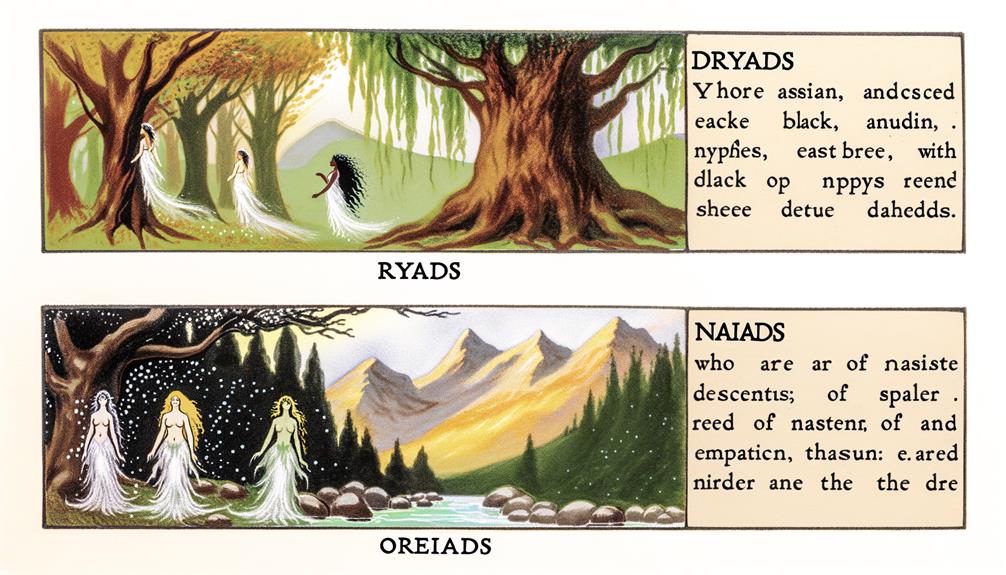
Diving into the complex world of nymph classifications, we encounter an array of different types such as Okeanides, Naiades, Dryades, and Hesperides. Each type is closely related to specific elements and phenomena in nature. In Greek mythology, nymphs are known as nature spirits and they hold a significant role beyond just being embellishments in Greek tales. They exemplify diverse facets of female nature, with each type of nymph, as well as individual ones, representing a particular part of the earth, sky, or sea.
Let's get a closer look at three types of Nymphs:
| Type | Domain | Role |
|---|---|---|
| Okeanides | Fresh water | They restore the earth's freshwater sources |
| Dryades | Forests and Trees | They are the protectors of forests, trees, and groves |
| Hesperides | Golden Apples | They safeguard Hera's golden apples |
For example, land nymphs such as Dryades, are often perceived as the embodiment of the caring aspect of nature. On the other hand, Okeanides which are connected with freshwater, and Hesperides, the protectors of Hera's golden apples, symbolize the richness and generosity of nature. This categorization of nymphs, which comes from the Greek word for bride, portrays a clear image of the versatile roles these spirits held in the natural environment.
Nymphs in Classical Literature
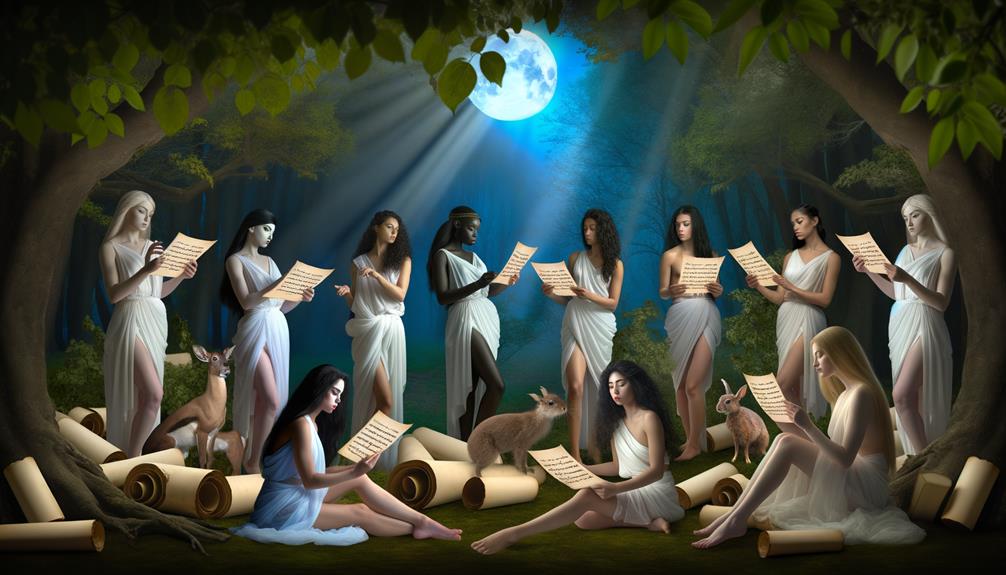
Nymphs have quite the reputation in classical literature, where they're typically depicted as otherworldly spirits linked to the tranquil charm and untamed strength of nature. They're portrayed as stunning women, representing the allure and power of nature itself. You'll find their stories scattered throughout works like the Homeric Hymns, where they personify the might of River Gods and the soothing influence of land nymphs.
When it comes to nymphs in classical literature, they're often portrayed as:
- Nymphae (Nymphs): This is a broad term for female spirits. They're usually shown hanging out with the gods or as crucial components of the natural world.
- Nymphs of the Trees: These are nature spirits linked to woods and forests, lending an enchanting touch to the green areas.
- River Nymphs: In myth, nymphs often have control over rivers, symbolizing the power and movement of these water bodies.
- Land Nymphs: These enchanting nature spirits are connected to the earth and its many landscapes, moulding the world with their otherworldly presence.
These portrayals of nymphs in classical literature highlight their significance in ancient stories and shed light on how the ancients interacted with their environment.
Nymphs Depicted in Art
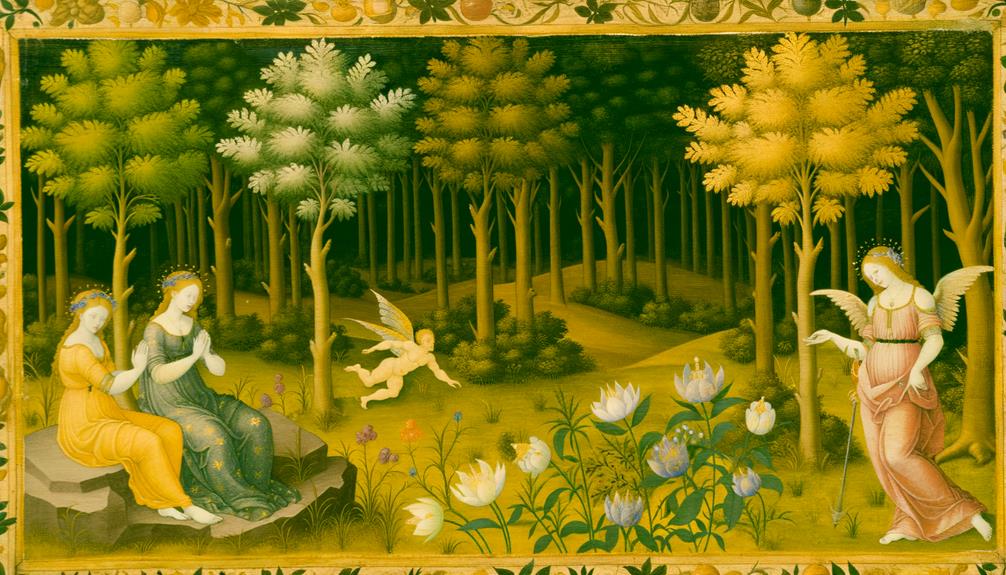
Nymphs, as visualized in art, are a stunning representation of nature's elegance. Often seen as the epitome of natural charm, these lovely ladies are commonly referred to as nymphs. Their portrayals in artistic works can differ greatly, ranging from roles as light-bringers to being the nymphs of the sea.
In many artworks, nymphs are placed amidst nature, their vibrant spirit reflecting the surrounding wildlife and plants. They are frequently shown as companions to gods and goddesses, highlighting their celestial importance. A well-known story that illustrates this is the legend of the golden apple, where nymphs play a central role.
To give a clearer picture, let's look at a chart that shows the various ways nymphs are represented in art:
| Visual Representations | Elements | Meaning |
|---|---|---|
| Light-bringers | Fire | Enlightenment, guidance |
| Sea nymphs | Water | Life, enigma |
| Golden apple holders | Fruit | Desire, conflict |
| Friends of the gods | Divine figures | Spirituality, respect |
| Spirits of nature | Trees, flowers | Development, energy |
Through these portrayals, nymphs symbolize the complex bond between humans and nature, their captivating presence being a tribute to the timeless beauty of the natural world.
Modern Interpretations of Nymphs
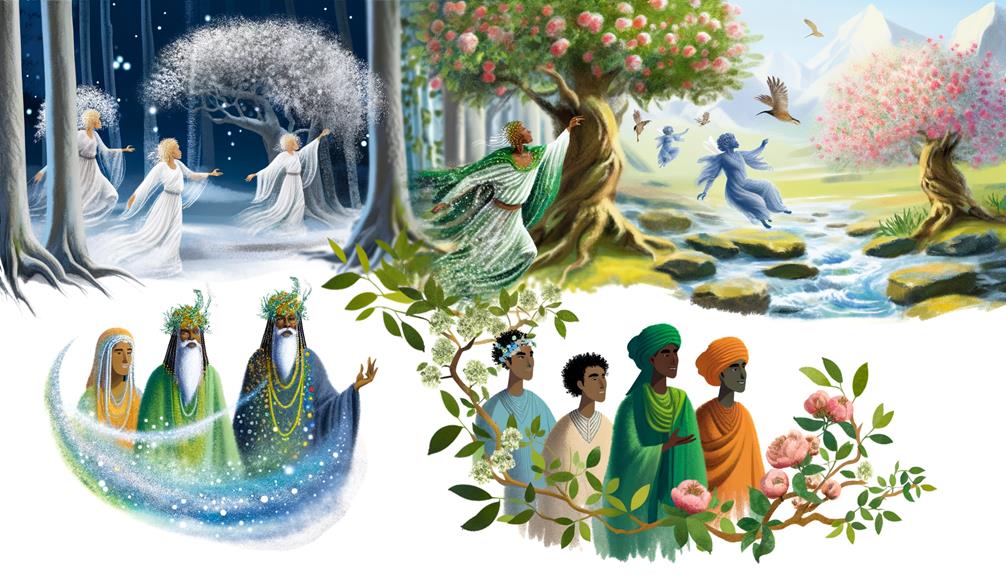
Let's chat about how nymphs, those enthralling spirits of nature from ancient lore, have been re-envisioned in our modern world. These days, they've become potent symbols, representing both the preservation of our environment and the empowerment of women.
Nymphs are frequently portrayed as the stewards of our Earth, protectors of trees, and guardians of fresh-water ecosystems.
- Their existence reminds us of our duty to conserve nature. Tree nymphs, who are seen as the embodiment of trees, highlight how crucial forests are for biodiversity and the fight against climate change.
- Nymphs, often depicted as beautiful women with long lives, elicit a sense of awe and admiration, representing the power and resilience of womanhood.
- Nymphs associated with fresh water underscore the importance of clean water for all life forms.
- Nymphs linked to honey, once tied to sweetness and abundance, are today viewed as advocates for sustainable farming.
These updated takes on nymphs breathe new life into old myths, making them relevant to our present-day issues. They encourage us to respect and safeguard our environment, and to acknowledge the strength and potential of women. Nymphs are no longer just attractive beings; they have become potent symbols for our era.
Frequently Asked Questions
Are Nymphs Nature Spirits?
Absolutely, nymphs are recognized as spirits of nature. They're commonly linked to different aspects of the natural world such as woodlands, waterways, and oceans. They hold an important position in supporting wildlife and act as a symbol of the bond between humans and the natural world.
What Are Nature Nymphs Called?
You know, it's pretty cool when you dive into Greek mythology, especially when you look at nature nymphs. These fascinating creatures have unique names that are linked to where they live. Take dryads for example – they're the nymphs you'll find hanging out in forests. Then we have naiads, who claim rivers as their home. And if you ever find yourself in the mountains, you might just run into an oread. These are all different types of nature nymphs, enchanting beings deeply connected to the natural world. Pretty amazing, right?
What Kind of Powers Do Nymphs Have?
I've always been intrigued by nymphs due to my deep affection for nature. These beings are famed for their knack in shaping the environment, fostering wildlife, and being a muse for poets. Some are even said to hold the uncanny ability to foresee the future and rejuvenate health.
What Is the Spiritual Meaning of a Nymph?
When I think about it, a nymph, in a spiritual sense, is like a divine representation of the splendor and might of nature. It's kind of like a metaphor for nurturing, innovation, and the deep connections we share with the world around us.

